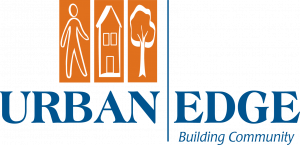
Digital Access Plan
Columbus Ave Corridor
Meeting II 1/14/2022
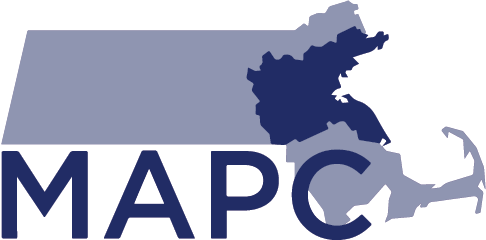
POST IN THE CHAT!
- Name
- Affiliation
- Name of the coldest place you have ever been!
Agenda
Welcome and Meeting Goals
Review of Project Process
Report Back on Community Needs Assessment
Technology Evaluation Preview

Next Steps
Please post questions and comments in the chat!
BREAK OUT GROUP DISCUSSIONS
Meeting Goals

Prioritize key findings from the Community Needs Assessment.
Brainstorm actions that could address digital divide issues along Columbus Ave.
Preview technology assessment concepts that MAPC will investigate further.

Phases of Work

- Evaluation of Current Internet Providers and Levels of Service
- Analysis of Community Access to Device and Internet
Phase 1A: Existing Conditions (July - August)
Phase 1B: Community Needs Assessment (August - December)
- Identification of Population Specific Challenges and Needs via Survey
- Focus Group(s) and Key Stakeholder Interviews with Community Members
-
Review of Existing Infrastructure and Assets Along Columbus Ave
-
Assessment of Potential Technology Interventions and Programs
Phase 2: Infrastructure and Technology Evaluation (January - March)
- Development of an Operational Framework that Urban Edge can use to Implement a Tech Solution, PLUS Programs for Skills Development and Community Ownership
Phase 3: Digital Operation Framework (April - May)
Help us see information from the community perspective
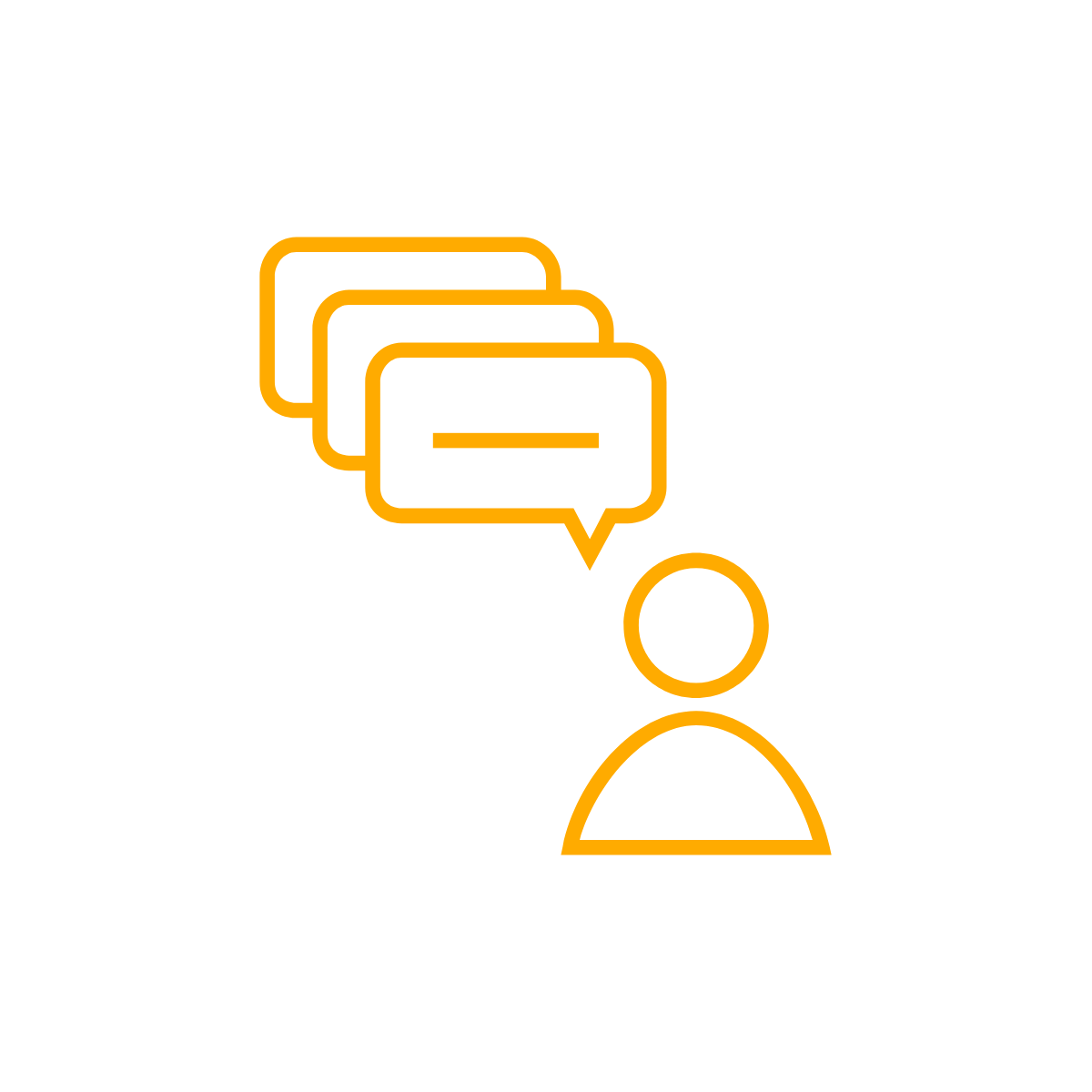


Provide feedback and response to proposed strategies
Assist in connecting with community members
Own this product
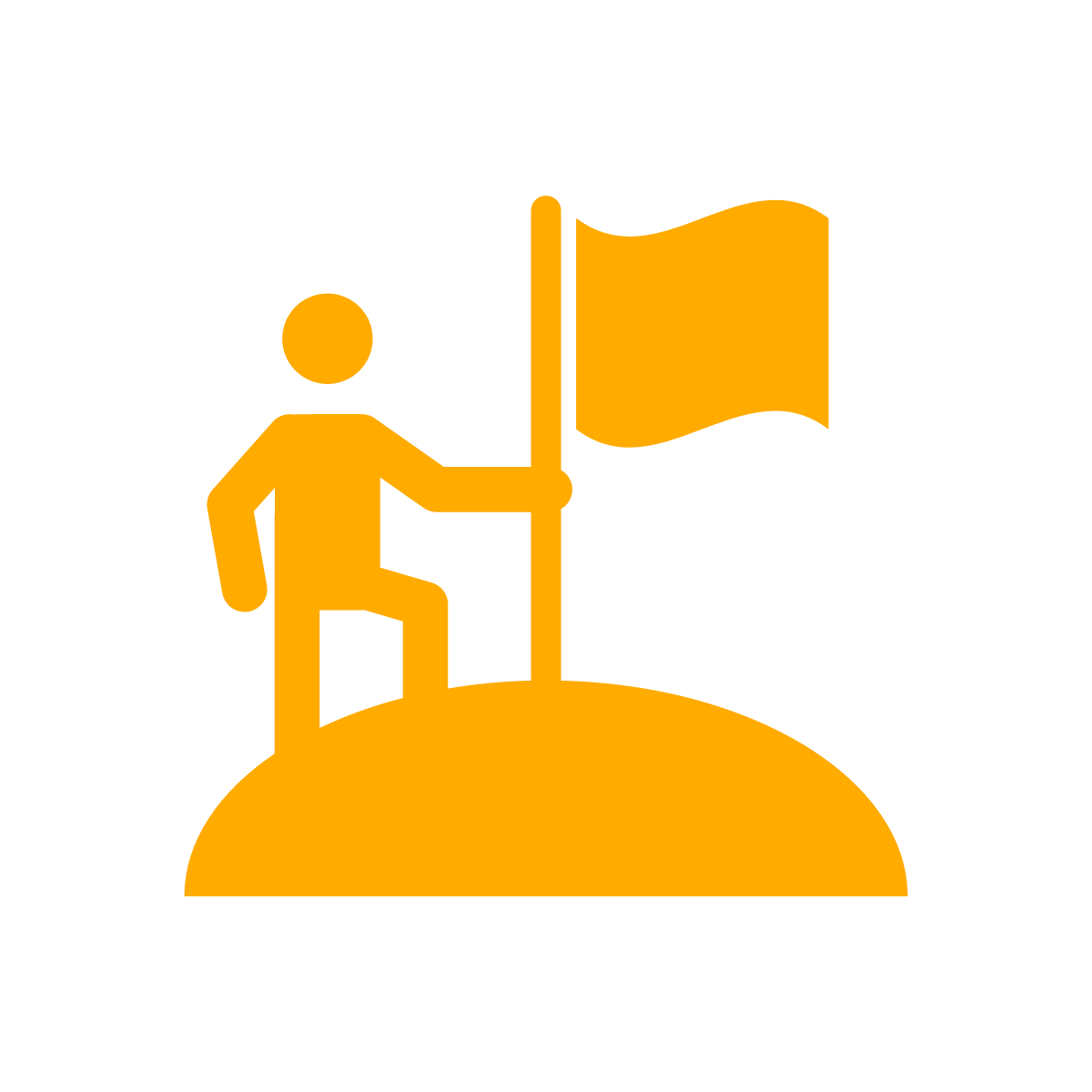
Advisory Committee Role
Community Needs Assessment--Urban Edge
Survey Data Review


An Adequate
Device
Literacy
Connection
Three Determining Factors of Digital Access


In June 2021 the U.S. Department of Commerce’s National Telecommunications and Information Administration (NTIA) released a map that displays key indicators of broadband needs across the country.
Columbus Ave Corridor stood out

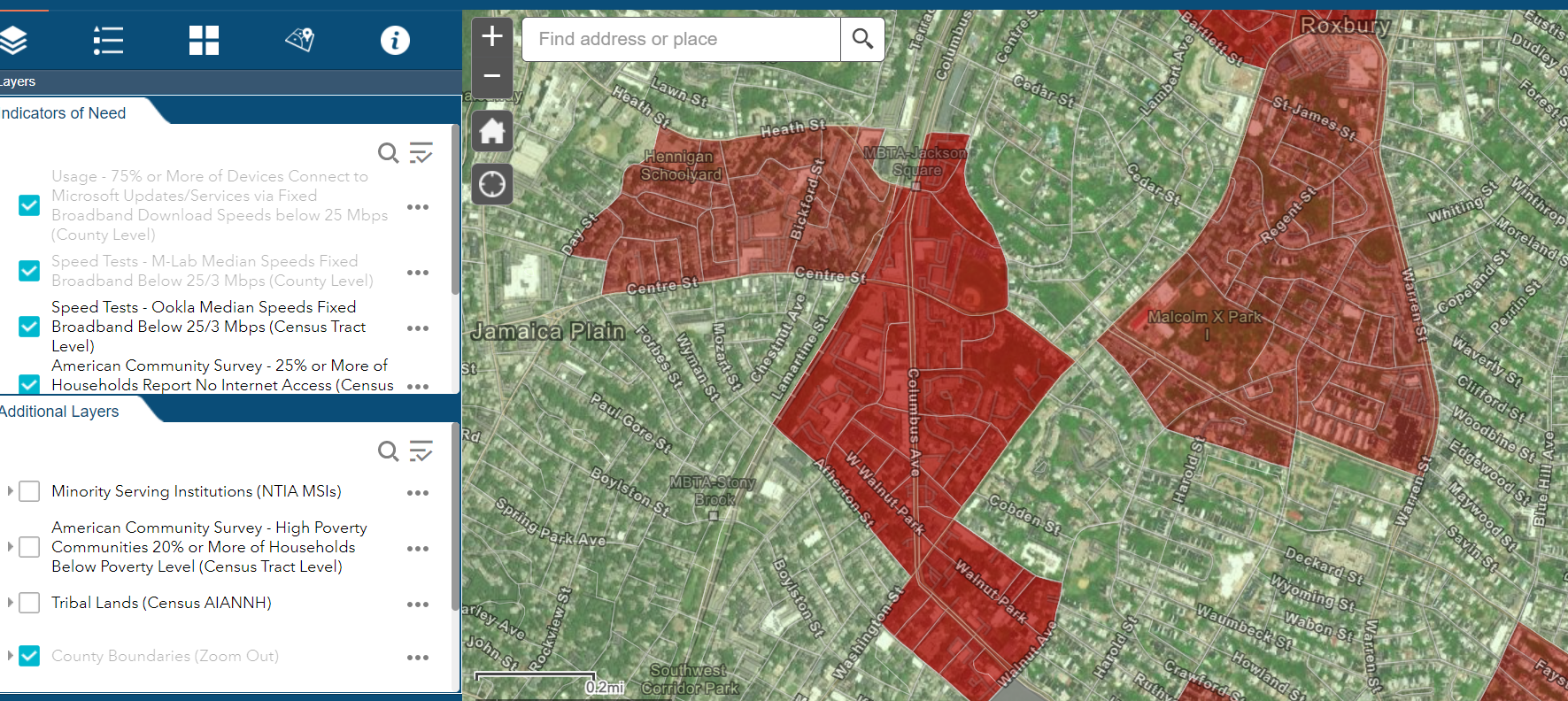
National
Indicators of Broadband Need


The Columbus Ave Corridor experiences substantially higher levels of digital divide issues than Boston as a whole.


Digital Access Needs Compared to Boston
Who Responded to the Survey?
Total Surveys Conducted
Target Survey Goal
Black / African American
200
265
Area Population
Race/Ethnicity
40%
Survey Results
35%
Black / African American
Seniors
Area PopulationAge
Surveys
19%
12%
Seniors
Hispanic or Latino
Hispanic or Latino
40%
56%
Total Surveys Conducted
Target Survey Goal
200
265
Area Population
Race/Ethnicity
40%
Seniors
Area PopulationAge
Surveys
19%
12%
Seniors
40%
Black / African American
Black / African American
35%
Area Population
Race/Ethnicity
Hispanic or Latinx
Hispanic or Latinx
40%
56%
According to Census data, 27 to 39% of “Columbus Ave Corridor” households do not have access to the internet.
What was learned from the Survey?
~27%
Of residents do not currently currently have an internet subscription.
That number is just 7% when we look at all US households

According to this Census data, 27 to 39% of “Columbus Ave Corridor” households do not have access to the internet.
Black or African American respondents were even less likely have an internet connection.
That number is just 7% when we look at all US households

73% of Black or African American respondents have an internet subscription. 81% of Hispanic or Latino residents have an internet subscription.

According to this Census data, 19% of “Columbus Ave Corridor” population are seniors.

What was learned from the Survey?
of seniors do not have an internet subscription in their home.
~54%
Affordability is often cited as a primary reason for the lack of an internet connection.
Is it Affordable?
~63%
of survey respondents without an internet subscriptions cite the reason as "too expensive"
52% of respondents have an annual household income of less than $25,000

Among non-broadband users, 45% say a reason why they do not have broadband at home is that the monthly cost is too expensive (Pew Researh Center)
Took action because of the large expense
~61%
of survey respondents have had to cancel or change their internet subscription because it is too expensive.

Among non-broadband users, 45% say a reason why they do not have broadband at home is that the monthly cost is too expensive (Pew Researh Center)
Affordability is often cited as a primary reason for the lack of an internet connection.
Is it Reliable?
of survey respondents have had to leave their home to use the internet at another location because their home service was unreliable
"Internet fee went up. It's too high while not being reliable."
For upload speed measured since 2017 in zip code 02119, 45% of the time the speed was under the threshold for broadband
~35%



Household Size and Reliability
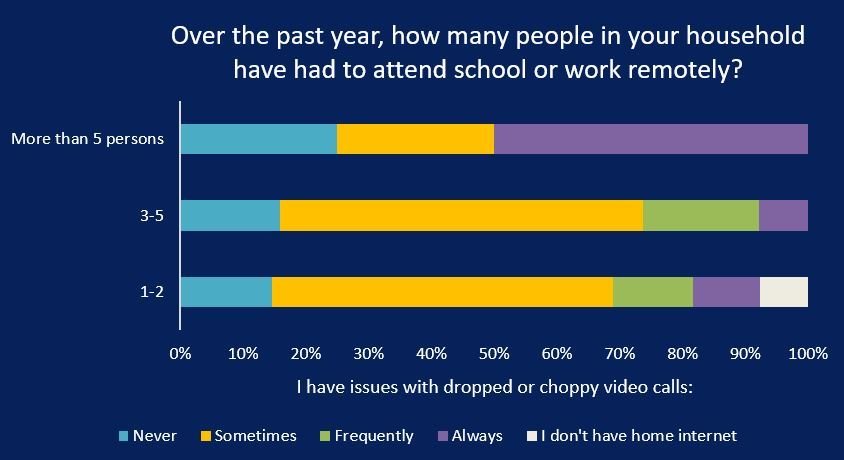
Price declines and quality increases are associated with the entry of a third broadband competitor (Benton Institute)
The majority of respondents were Comcast customers
"Comcast es muy caro y además tiene un monopolio con el servicio de cable e internet"
--
"Comcast is very expensive and also has a monopoly on cable and internet service"



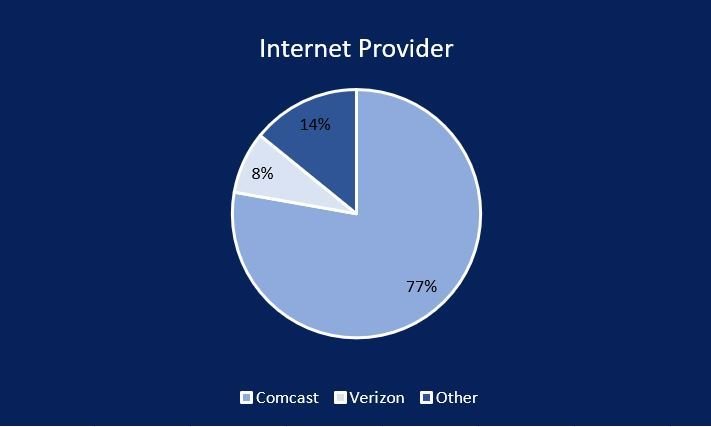
What about subsidy programs that provide free discounted internet connections?
Survey found that:
Providers are federally mandated to offer low-income eligible service plans. Comcast calls their plan Xfinity Internet Essentials.
It offers basic internet service for $10 / Month to income-eligible households (SNAP, Free or Reduced Lunch, etc)
~52%
of all respondents are Xfinity Internet Essentials Subscribers

What about subsidy programs?
Can you find out if academy homes 1 will provide internet again and if we can bring RCN because Comcast rips off customers and I'm disabled can you find internet services for home free or low for the month. Thanks in advance


Only 1,043 households
have taken advantage of EBB since November 1, 2021 in zip code 02119
In addition to provider programs, there is currently The Emergency Broadband Benefit program (EBB)* will subsidize $50 for all service plans

There are 11,048 total households in zip code 02119 (US Census) .
*On 12/31/2021 the EBB program ended, and the Affordable Connectivity Program created, providing a $30 monthly subsidy for service plus $100 credit toward computer or tablet purchase.
Affordability is not the only barrier to adoption.
What was learned from the Survey?
~15%
of those without an Internet subscription say they don't know how to subscribe

Comfortable Using Technology
~82%
of survey respondents agree with "I feel confident in my ability to use a computer/laptop/Chromebook".

100% of survey respondents under the age of 24 agree with "I feel confident in my ability to use a computer/laptop/Chromebook"
~57%
of survey respondents agree with "I feel confident that I am able to resolve issues related to my internet connection"

"If training was available I would like to learn more about technology"


Less Comfortable Ensuring Functioning Equipment

38%
of respondents disagree with "People in my household always have access to a computer if needed"
Device Access
According to Census data, 20 to 27% of "Columbus Ave Corridor" households do not have a computer.
45%
of survey respondents have had to buy a new computer in the last 3 years

New device needed
Why did you purchase a new or used computer in the last 3 years?
"Porque no tenia una y mis hijo lo necesitaban cuando empezo la pandemic para sus classes en escuela por lo general nosotros tenemes celulares pero no se podian utilisar para las clases en lineas"
--
"Because I didn't have one and my children needed it when the pandemic started for their classes in school usually we had cell phones but they could not be used for online classes"


71%
of respondents cite that more than one person in their household needs to use the internet "Always" or "Frequently"

For 1-2 people, internet should be at least 25-50 Mbps.
For 3-4 people, internet should be at least 50-100 Mbps.
For 5+ people, internet should be at least 200-500 Mbps.
Device Use
Thematic Findings

Connection
Data demonstrates a confusion around Internet service packages and programs to support low-cost adoption.
Lack of Awareness of Supports
Thematic Findings

Connection
Insert text about Comcast/Benton Institute competition numbers
Lack of Competition
Thematic Findings

Connection
Families struggle with quality issues with broadband service.
Household Size
Thematic Findings

Connection
According to survey results, seniors lack connectivity and confidence in their ability to use a computer.
Seniors
Thematic Findings
Devices
38% of survey respondents disagree with the statement "People in my household always have access to a computer if needed".
Device Access

Thematic Findings
Digital Literacy
Survey data and focus group conversations demonstrate confusion around Internet service packages and digital literacy program offerings
How we talk about the Internet

Thematic Findings
Digital Literacy
Survey data shows general interest in digital literacy and potential careers in technology.
Interest in Technology

Affordability is often cited as a primary reason for the lack of an internet connection.
What was learned from the Survey?
50%
of survey respondents do not believe their internet service is affordable.
PEW #
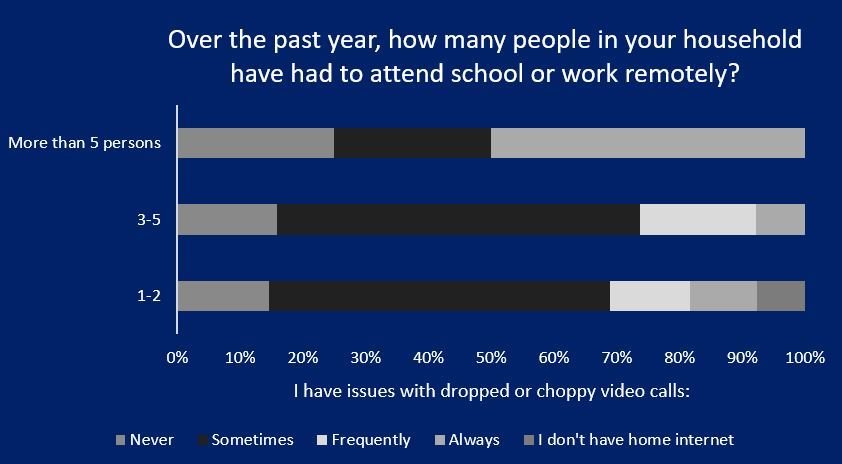
Who Responded to the Survey?

46% of respondents are over the age of 46
40% of respondents are Spanish speakers
95% of respondents rent their home, 74% rent from Urban Edge
64% of respondents have lived at their current address for 5 years or more
42% of respondents have 0 children living in their home
56% of respondents identify as Hispanic or Latino
35% of respondents identify as Black or African American
52% of respondents are Xfinity Internet Essentials Subscribers
52% of respondents have an annual household income of less than $25,000
Community Needs Assessment--Urban Edge
Stakeholder Interviews
Focus Groups
Individual Conversations
Process
Sample Questions:
Warren Williams, E.D, Three Squares Main Streets
Sandra Waldon, Dimmock Health Center
Mike Lynch, City of Boston, Director of Broadband and Cable
Salvatore Pina, Roxbury Community College (RCC), Director of Workforce Development
Amy Nishman, Jewish Vocational Services (JVS), Senior Vice President of Strategy
Nessie Ruiz, Tech Goes Home
Milton Erving and Allessandra Brown, Timothy Smith Network
Scott Hagerty, InSource
Denise Delgado, Egleston Square Main Streets (email correspondence)
Urban Edge residents and community leaders
Urban Edge Staff
Affordable Housing Groups, JPNDC, TNB, MACDC, Winn Companies
What barriers do you see for your neighbors in getting online?
What opportunities might be created if there was improved ability to get online?
How are you thinking about the Digital Divide, and how it fits into your mission and programming?
Please identify the network of partners in the area, and the physical, operational and organizational assets they might bring to the project.

Focus Groups
Individual Conversations
Constituents
Warren Williams, E.D, Three Squares Main Streets
Sandra Waldon, Dimmock Health Center
Mike Lynch, City of Boston, Director of Broadband and Cable
Salvatore Pina, Roxbury Community College (RCC), Director of Workforce Development
Amy Nishman, Jewish Vocational Services (JVS), Senior Vice President of Strategy
Nessie Ruiz, Tech Goes Home
Milton Erving and Allessandra Brown, Timothy Smith Network
Scott Hagerty, InSource
Denise Delgado, Egleston Square Main Streets (email correspondence)
Urban Edge residents and community leaders
Urban Edge Staff
Affordable Housing Groups, JPNDC, TNB, MACDC, Winn Companies
Families
Continuing Ed
students
Seniors
Mildred Hailey
residents
IT Clients
Business
owners
Jobseekers
Immigrants
Transitional
housing
residents
Healthcare
patients

Commonly identified needs
Digital Equity Needs
Connection, literacy and devices must work together. Even with the existence of an internet connection, residents need support in strengthening literacy skills and accessing devices. Language barriers limit the effectiveness of digital equity efforts.
Stakeholders highlighted the need for internet access in order to allow community members to attend school, conduct work, search for jobs, access government assistance, and connect with friends and family. The need is even greater amongst the marginalized communities stakeholders serve.
There are a limited number of existing digital access programs (supported by TGH), and a strong desire was expressed for these programs, either by residents or by organizations who believe increased digital literacy will improve their own services. Stakeholders highlighted the digital literacy needs of seniors, career (re)training, business owners and ESL learners.
Businesses should better take advantage of online tools and be "document ready"




| Infrastructure | Digital Literacy | Workforce Dev | Device access | |
|---|---|---|---|---|
| Urban Edge | ||||
| Jewish Vocational Services | ||||
| City of Boston | ||||
| Tree of Life | ||||
| JP Neighborhood Development Corp | ||||
| The Community Builders | ||||
| WinnCompanies | ||||
| InSource | ||||
| Roxbury Community College | ||||
| Timothy Smith | ||||
| Three Squares Main Streets | ||||
| Egleston Square Main Streets | ||||
| The Dimock Center | ||||
| Tech Goes Home | ||||
| Boston Neighborhood Network |
Asset Map
Consistent Themes
Stakeholder Insights
Many of the stakeholders are open to partnership and collaboration between organizations, and a desire to increase their work in helping to close the digital divide.
Stakeholder organizations identified the incoming state and federal aid as a resource for this work, but are unsure of how to proceed. Collaboration within groups and with the City of Boston is likely necessary in order to qualify for these funds.


Existing Capacity: Connection
InSource, Urban Edge's IT consultant, manages the in-building network (wiring installed during its renovation) at Walnut Park and soon to be completed Holzer park. Currently these networks offer minimal bandwidth to users but that can be increased.
Boston has municipal fiber in the corridor, nearby to BHA's Doris Bunte apartments, RCC, BNN and several Wicked Free WIFI hotspots.
Recent construction or renovations have included in-building wiring, allowing ISP's easier access to apartments and the ability for building owners to consolidate accounts.
As a group, the stakeholders manage a large and diverse portfolio of real estate, creating opportunity for shared broadband infrastructure.

Existing Capacity: Devices

Tech Goes Home has created a fee for service program where they used to not charge partners. Urban Edge is piloting a device and literacy program for youth and seniors with Tech Goes Home, and JVS has a partnership with them as well.
RCC has a Timothy Smith Network Space (computer lab), open to the public.
Library, schools laptop and hotspot lending programs

Existing Capacity: Digital Literacy

Urban Edge is piloting a program for youth and seniors with Tech Goes Home.
Jewish Vocational Services also works with TGH, and developed a Digital Navigator program.
Three Squares is working with JPNDC to aid businesses to become document ready. Work between Three Squares and RCC and Ben Franklin Institute of Technology is ongoing.
RCC and The Timothy Smith Network offer specialized technology career training.
Existing Capacity

Tech Goes Home has created a fee for service program where they used to not charge partners. Urban Edge is piloting a device and literacy program for youth and seniors with Tech Goes Home, and JVS has a partnership with them as well.
RCC has a Timothy Smith Network Space (computer lab), open to the public.
Library, schools laptop lending programs
Existing Capacity: Devices

Existing Programs
Stakeholder Insights
Tech Goes Home has created a fee for service program where they used to not charge partners. Urban Edge is piloting a program for youth and seniors with Tech Goes Home, and JVS has a partnership with them as well.
InSource is Urban Edge's IT consultant. In addition to Urban Edge offices, InSource manages the in-building network (wiring installed during its renovation) at Walnut Park and soon to be completed Holtzer park. Currently these netowrks offer minimal bandwidth to users but that can be easily increased.
Three Squares is working with JPNDC to aid businesses to become document ready. Work between Three Squares and RCC and BFIT is ongoing.
RCC has a Timothy Smith Network Space (computer lab)
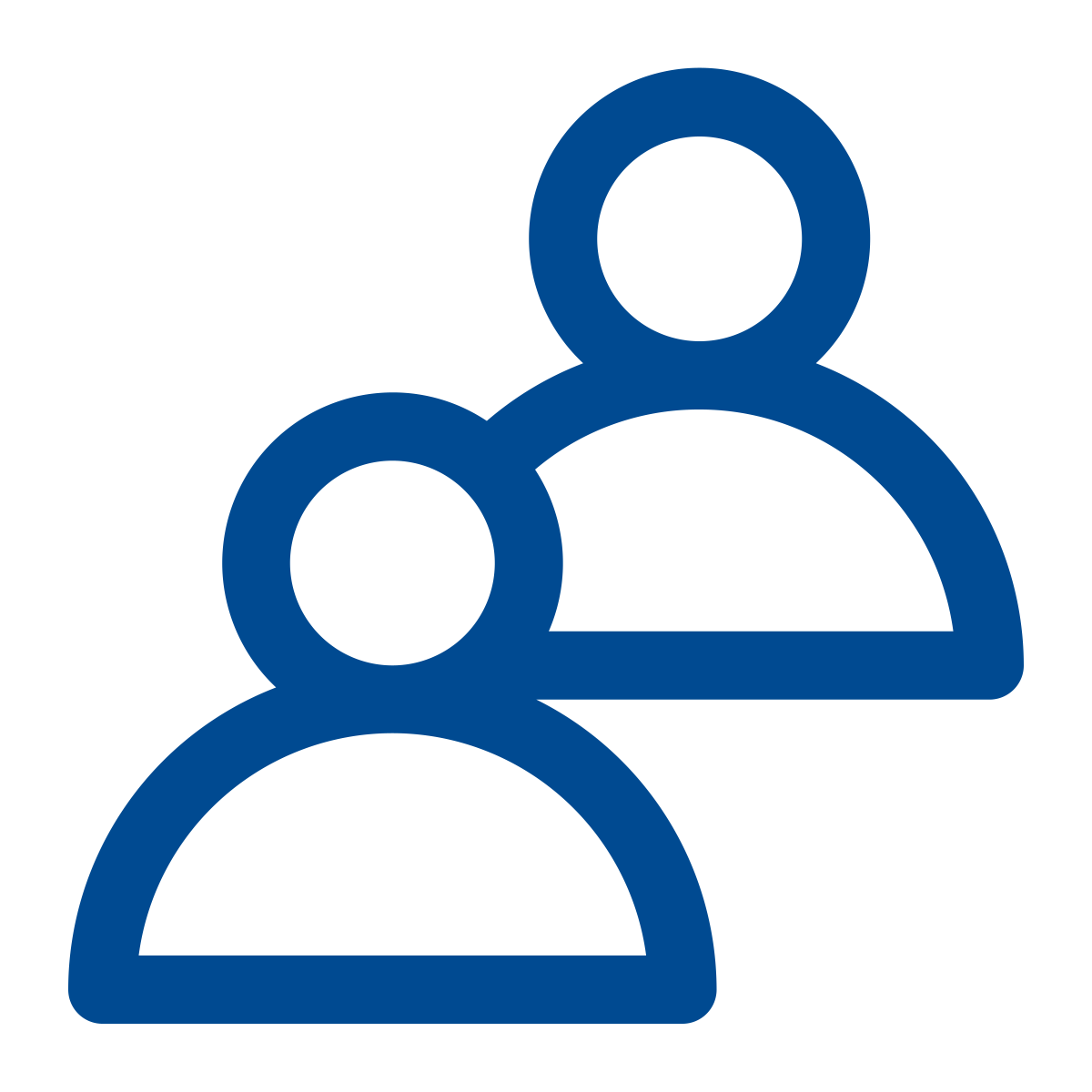



Remove slide, replace with following 3 slides.
Opportunities
Stakeholder Insights

At the Mildred Hailey site with JPNDC and UE, they want to add a business center and bring Wi-Fi to the community center during the renovation, setting a new benchmark for connectivity with the Mildred Hailey redevelopment
Free internet in public parks
Internet in unit
Working with Amazon for funding in Roxbury where they have a large giving budget



Dimmock HR program could focus on more digital offering

Digital Literacy for Latinos

Tech Goes Home considering becoming an ISP


(Affordable Housing) If you have significant reserves and you can talk to the lender about it to authorize it, you may be able to use the reserves, and solve for the operating expense. All properties have operating reserves, required by lenders in the state. Each has different requirements. It is an eligible use for the operation of the building (from the reserves), but installation is a grey area, as it is not exactly a replacement, but that is often up to the funder that holds the replacement reserve.
One org is a funnel to programs feeding to one org doing digital literacy feeding to one org doing career training

A public free network may be able to be supported by the City of Boston

Remove slide
Community Needs Assessment--Urban Edge
Key Findings
Key Findings



Connection
Devices

Digital Literacy

Connection


Need
Solutions
The adoption of home internet along the Columbus Ave corridor is lower than Boston overall, driven in large part by lack of affordability
- Promote discount programs of providers
- Promote consumer ISP options
Healthcare Providers
Municipal Support
Local Media
CBO's
CDC's
- Install in-building wiring for aggregated demand and service
Lack of awareness of Internet subsidy programs limits broadband adoption.
Little competition among ISP's limits affordability and quality.
Connection


Need
Solutions
Families struggle with quality issues with broadband servicedue to increased device usage and bandwidth needs.
Larger households require better internet speeds at affordable prices.
- Install in-building wiring for aggregated demand and service
- Explore community or affordable housing broadband network options
- Increase competition to improve service
CDC's
IT Vendor
Municipal Support
Devices


Need
Solutions
38% of survey respondents disagree with the statement "People in my household always have access to a computer if needed."
- Tech Goes Home training for families
- More open access computer labs, with support
- Promote discounted device purchase and lending options
- EBB/ACP program provides $100 computer rebate
Nonprofits
Libraries
Schools
CDC's
Families, with demands of remote work and school, require more devices.
Digital Literacy


Need
Solutions
Almost half of seniors reported a lack of confidence in their ability to use a computer.
Stakeholders reported that households that speak a language other than English require language-specific training and literacy programs.
- Targeted approaches to basic digital literacy training (senior focused, multiple languages)
- Employ skill assessment tools to differentiate literacy needs
CDC's
Nonprofits
Technology trainers
Healthcare providers
Older adults require digital literacy training, in their home language.
Digital Literacy


Need
Solutions
Youth and young adult residents require programming to support their education and career aspirations.
- Programs such as Digital Stewards and others where community members design and digital equity efforts
Workforce Development
Educational Institutions
Community Based Org's
Leverage young people’s interest in technology to support careers and potential infrastructure in the corridor
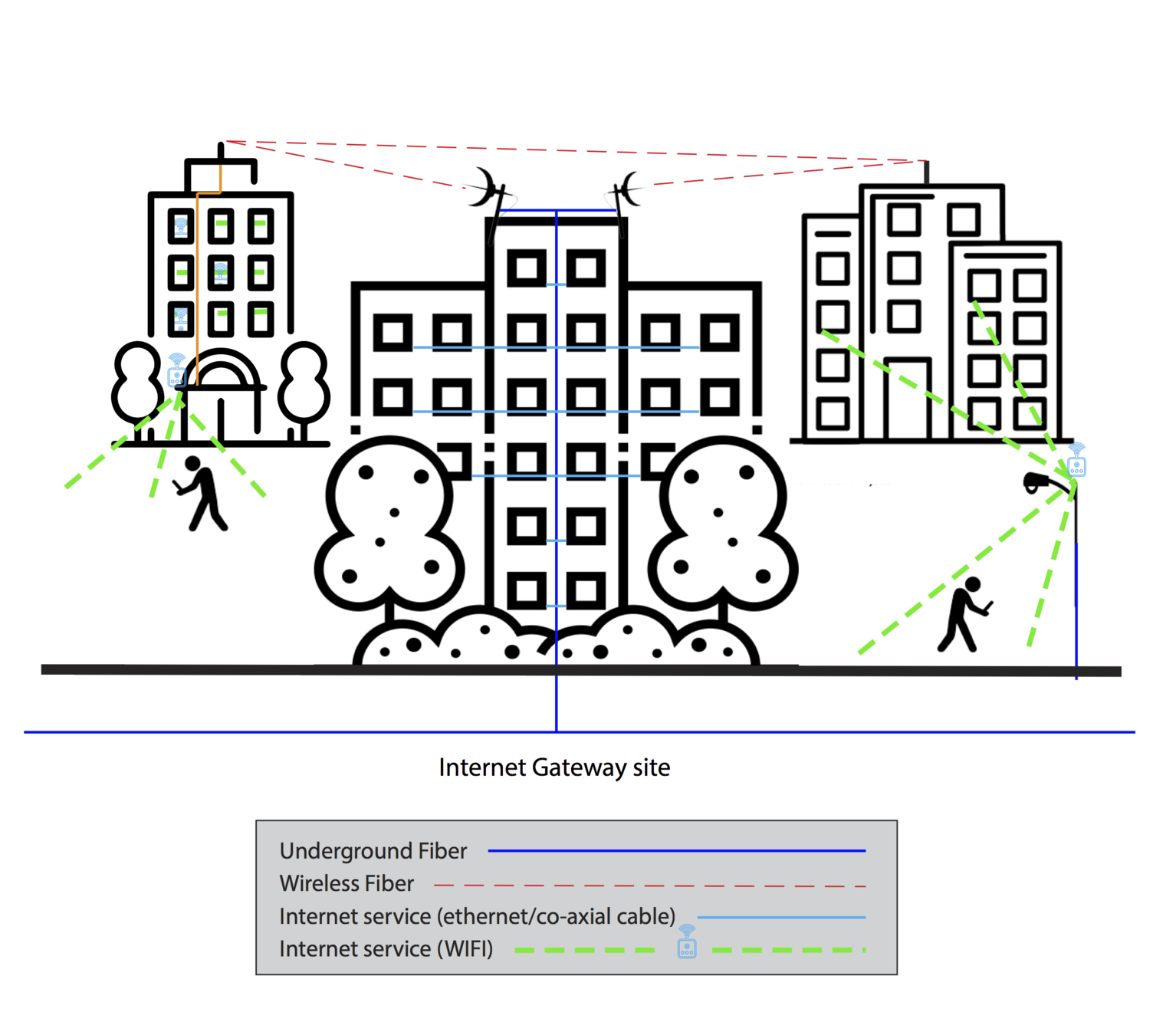
Alternate Slides
Key Findings-Infrastructure

- 54% of seniors do not have an Internet subscription in their home.
- 77% of Internet users are Comcast customers
- 52% are Xfinity Internet Essentials
- 35% of survey respondents have had to leave their home to use the Internet at another location because their home service was unreliable
- Majority of stakeholders interviewed manage broadband infrastructure components-buildings, community spaces, computer labs
Comcast is the ISP for the large majority of residents, despite issues of quality. Outreach to seniors and low income residents for Internet Essentials is lacking as are affordable alternatives.
Key Findings-Devices

- 38% of survey respondents disagree with "People in my household always have access to a computer if needed."
- 51% attended or work or school remote
- Lack of public computer labs
Many Columbus Corridor residents attended school or work remotely in 2021. Many reported not having necessary computers, and local options for affordable device purchases or borrowing are minimal.
Key Findings-Targeted Approaches

- Stakeholders highlighted the digital literacy needs of seniors, career (re)training, business owners and ESL learners.
- ~45% of seniors disagree with the statement "I feel confident in my ability to use a computer/laptop/Chromebook" (number increases to ~70% of those uncomfortable with their ability to fix Internet issues)
- 30% of Haitian Creole speakers (and ~20% of Spanish speakers disagree with the statement "I feel confident in my ability to use a computer/laptop/Chromebook"
-
59% agree with the statement "If training were available, I would be interested in a career in the Technology or IT Field"
- 100% of respondents ages 19-24 agree with the statement "If training were available, I would be interested in a career in the Technology or IT Field
When results are broken down by age/race, distinctive needs and interests are revealed. Stakeholders echoed that need for specific types of training.
Key Findings-How we talk about the Internet

- Many more households qualify for EBB/ACP than are registered
- %__of Infinity Internet Essentials customers report spending +$100 per month on Internet subscription
- 57% feel confident in resolving issues related to Internet connection vs 82% confident in resolving computer/laptop/Chromebook issues
- 15% of those without Internet access in the home answered "Dont know how to subscribe" as their reason
Discrepancies in data demonstrate a lack of clarity on ISP offerings, broadband service, and program offerings.